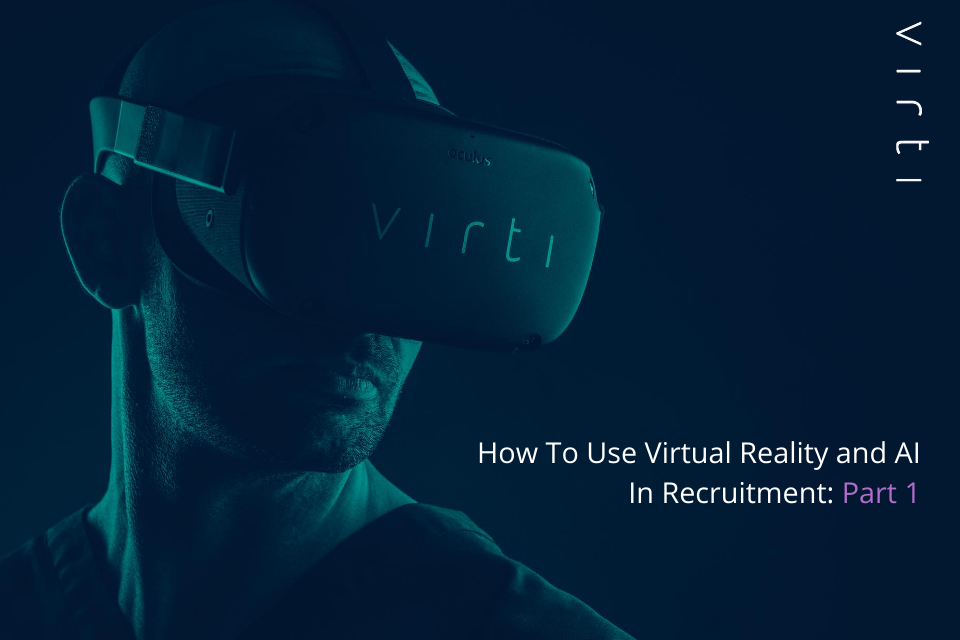How To Use Virtual Reality and AI In Recruitment: Part 1

How Can Virtual Reality Transform Your Hiring Process?
In the first of this two-part series, we’re exploring how virtual reality and artificial intelligence are transforming the hiring and training processes for businesses.
At Virti we are extremely excited about what Virtual Reality (VR) and Artificial Intelligence (AI) technologies stand to bring to the recruitment and training industries. But as sector pioneers, we know that how technology is used is just as important as what tech is used. As we discuss in this blog, companies who are serious about future-proofing their recruitment, diversifying their teams and laying the foundations for success must start by opening themselves up to a wholly new way of discovering and assessing talent.
The COVID-19 pandemic has accelerated the integration of VR and AI in every sector. In the field of training and recruitment, the adoption of immersive technologies is picking up speed rapidly. This trend is not only being driven by lockdown - but also by the promise of a more powerful and scalable way of assessing candidates and training new hires.
In this article, we look at what immersive technology actually is, why it’s so exciting, and how it can be used to find and train the best talent.
Immersive technology explained
Immersive technology is an integration of digital content with the physical environment in a way that allows the user - who accesses the content via a headset, mobile phone, or other digital device - to fluidly engage either with a completely virtual or ‘blended’ reality.
Immersive technologies include:
- Virtual reality (VR), which immerses users in a fully artificial digital environment or 360-degree video
- Augmented reality (AR), which overlays virtual objects on the real-world environment
- Mixed reality (MR), which not only overlays, but anchors virtual objects to the real world
Recent research has proven that the use of interactive, immersive technologies for education or training significantly improves knowledge retention and confidence levels whilst reducing skill fade and anxiety. Evidently, it’s not only social distancing restrictions which have driven the rapid growth of immersive training, remote learning and soft-skills training via virtual or mixed-reality platforms, but the very real benefits it brings to individuals and organisations.
Applications of immersive technology for businesses
In a post-pandemic world, the most successful businesses are going to be those that seize effective alternatives to face-to-face meetings, training and conferencing.
Virtual Reality, Augmented Reality and Mixed Reality tools are leagues apart from more traditional video conferencing platforms. Indeed, the possibilities these sophisticated technologies offer for highly effective, scalable simulation training and conferencing are already being embraced enthusiastically.
Subsequently, integrating the very latest immersive technology into a company’s recruitment and hiring process is a natural next step. From catching the attention of the brightest young students to using bias free, AI-driven insights to select the perfect candidate, the potential for positive industry disruption is hugely refreshing.
Using Immersive technology to attract top talent
When it comes to reaching out to potential candidates (especially students) immersive, interactive games and challenges are a great way for companies to speak directly to their target hires. The creation and distribution of customised VR and AR games allows players to try their hand at tasks that employees encounter on a daily basis. Not only is this a great way to create noise and visibility, but individuals who enjoy playing the game are also more likely to apply for a position with the company. This method of recruitment outreach is highly scalable, as players can access the content from a mobile device or desktop as well as any brand of VR headset.
After catching the attention of applicants using VR technology, the same tools can also be used on the next stage of the recruitment process.
Although it’s logistically challenging and increasingly expensive to host potential candidates for visits to your company premises, the majority of applicants will want to experience their potential future working environment, and to deny them this could cost you their candidacy. By employing custom-made 360-degree video overlaid with unique audio, it is possible to offer a realistic and attractive premises tour which candidates can access on any digital device. This gives employers the chance to show off their work environment, facilities and locality in a controlled manner, breaking down barriers of access and encouraging applicants to envision themselves as a part of the company landscape.
Want to learn more? To find out how the same technology, coupled with insights from integrated artificial intelligence, can be used to remotely assess job candidates and promote employee diversity, look out for Part 2 of this series next week.
